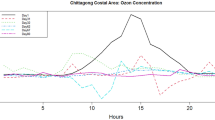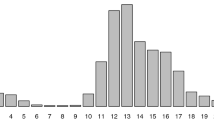Abstract
Due to the nonlinear feature of a ozone process, regression based models such as the autoregressive models with an exogenous vector process (ARX) suffer from persistent diurnal behaviors in residuals that cause systematic over-predictions and under-predictions and fail to make accurate multi-step forecasts. In this article we present a simple class of the functional coefficient ARX (FARX) model which allows the regression coefficients to vary as a function of another variable. As a special case of the FARX model, we investigate the threshold ARX (TARX) model of Tong [Lecture notes in Statistics, Springer-Verlag, Berlin, 1983; Nonlinear time series: a dynamics system approach, Oxford University Press, Oxford, 1990] which separates the ARX model in terms of a variable called the threshold variable. In this study we use time of day as the threshold variable. The TARX model can be used directly for ozone forecasts; however, investigation of the estimated coefficients over the threshold regimes suggests polynomial coefficient functions in the FARX model. This provides a parsimonious model without deteriorating the forecast performance and successfully captures the diurnal nonstationarity in ozone data. A general linear F-test is used to test varying coefficients and the portmanteau tests, based on the autocorrelation and partial autocorrelation of fitted residuals, are used to test error autocorrelations. The proposed models were applied to a 2 year dataset of hourly ozone concentrations obtained in downtown Cincinnati, OH, USA. For the exogenous processes, outdoor temperature, wind speed, and wind direction were used. The results showed that both TARX and FARX models substantially improve one-day-ahead forecasts and remove the diurnal pattern in residuals for the cases considered.






Similar content being viewed by others
References
Akaike H (1974) A new look at statistical model identification. IEEE Trans Automat Contr AC-19:716–723
Bauer G, Deistler M, Scherrer W (2001) Time series models for short term forecasting of ozone in the eastern part of Austria. Environmetrics 12:117–130
Bloomfield P, Royle JA, Steinberg LJ, Yang Q (1996) Accounting for meteorological effects in measuring urban ozone levels and trends. Atmos Environ 30(17):3067–3077
Box GEP, Jenkins GM (1976) Time series analysis:forecasting and control, revised edn. Holden Day, San Francisco
Cai Z, Fan J, Li R (2000) Efficient estimation and inferences for varying-coefficient models. J Am Stat Assoc 95:888–902
Chen R, Tsay R (1993) Functional-coefficient autoregressive models. J Am Stat Assoc 88:298–308
Cleveland WS, Grosse E, Shyu WM (1991) Local regression models. Statistical Models in S, 309–376, Wadsworth, Pacific Grove
Damon J, Guillas S (2002) The inclusion of exogeneous variables in functional autoregressive ozone forecasting. Environmetrics 13:759–774
Davis MD, Deistler M (1998) Modeling ozone in the Chicago urban area. In: Nychka D, Piegorsch W, Cox LH (eds) Case Studies in Environmental Statistics, Lecture Notes in Statistics. Springer, Berlin
Fan J, Zhang W (1999) Statistical estimation in varying coefficient models. Ann Stat 27:1491–1518
Fasso A, Negri I (2002) Non-linear statistical modeling of high frequency ground ozone data. Environmetrics 13:225–241
Fiester U, Balzer K (1991) Surface ozone and meteorological predictors on a subregional scale. Atmos Environ 25:1781–1790
Hastie TJ, Tibshirani RJ (1993) Varying-coefficient models (with discussion). J R Stat Soc B 55:757–796
Hui K-J (1992) Time series of the analysis of the interdependence among air pollutants. Atmos Environ 26:491–503
Kumar A, Bellam N, Sud A (1999) Performance of industrial source complex model in predicting long-term concentrations in an urban area. Environ Prog 18(2):93–100
Ljung GM, Box GEP (1978) On a measure of lack of fit in time series models. Biometrika 65:297–303
Meng Z, Dadub D, Seinfeld JH (1997) Chemical coupling between atmospheric ozone and particulate matter. Science 227:116–119
Merz PH, Painter LG, Ryason PR (1972) Aerometric data analysis. Time series analysis and forecast and an atmospheric smog diagram. Atmos Environ 6:319–342
Millionis M, Davies TD (1994) Regression and stochastic models for air pollution-I. Review, comments and suggestion. Atmos Environ 28(17):2801–2810
Monti AC (1994) A proposal for residual autocorrelation test in linear models. Biometrika 81:776–780
Schwarz F (1978) Estimating the dimension of a model. Ann Stat 6:461–464
Seinfeld JH (1998) Ozone air quality models:a critical review. J Atmos Pollut Control Assoc 38:616–647
Simpson RW, Layton AP (1983) Forecasting peak ozone levels. Atmos Environ 17:1644–1654
Tong H (1983) Threshold models in non-linear time series analysis. In: Brillinger D, Fienberg J, Gani J, Hartigan J, Krickberg K (eds) Lecture Notes in Statistics. Springer-Verlag, Berlin
Tong H (1990) Nonlinear time series: a dynamic system approach. Oxford University Press, Oxford
Acknowledgements
The authors wish to express thanks to Anna Kelley with HCDOES for providing us with the data. Thanks also to the three reviewers who made very helpful comments on this manuscript.
Author information
Authors and Affiliations
Corresponding author
Rights and permissions
About this article
Cite this article
Kim, S.E., Kumar, A. Accounting seasonal nonstationarity in time series models for short-term ozone level forecast. Stoch Environ Res Ris Assess 19, 241–248 (2005). https://doi.org/10.1007/s00477-004-0228-y
Published:
Issue Date:
DOI: https://doi.org/10.1007/s00477-004-0228-y




